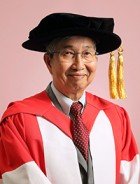

Professor Tang Ching Wan is the IAS Bank of East Asia Professor of the HKUST Jockey Club Institute for Advanced Study at the Hong Kong University of Science and Technology, and Professor Emeritus at the University of Rochester, New York. He received his primary and secondary school education in Hong Kong and holds a BSc in Chemistry from the University of British Columbia and a PhD from Cornell University.
Professor Tang is best known for his work on organic optoelectronics, the research field related to electronic devices based on organic semiconductors. In particular, he has been recognised for the invention of the Organic Light Emitting Diode (OLED).
Between 1986 and 1989 while he was a researcher at the Kodak Research Laboratories, Professor Tang transformed the field of organic optoelectronics with his discovery of the donor-acceptor bilayer structure, also known as the organic heterojunction, which allows the generation and recombination of charges to be manipulated to produce highly efficient optoelectronic devices.
He discovered OLED in a sequel to his work on organic solar cells. By engineering an organic heterojunction with luminescent semiconductors of proper energetics, he demonstrated an efficient light emitting device capable of producing high brightness at a low voltage. Published in 1987 and cited over 10,000 times, his research gave birth to OLED technology. By 1989, he had developed an important method for tuning OLED colours, leading to the fabrication of full-colour OLED displays.
Today, OLED technology is a multibillion-dollar industry and is used in many of the consumer and household electronic devices we all take for granted, including mobile phones and televisions.
Professor Tang was awarded the prestigious Wolf Prize in Chemistry in 2011 and is a Founding Member of the Academy of Sciences of Hong Kong, a Fellow of the Hong Kong Academy of Engineering Sciences, and a member of the US National Academy of Engineering.
In recognition of his contributions to science, society and the world, the University has resolved to confer upon him the degree of Doctor of Science honoris causa.



